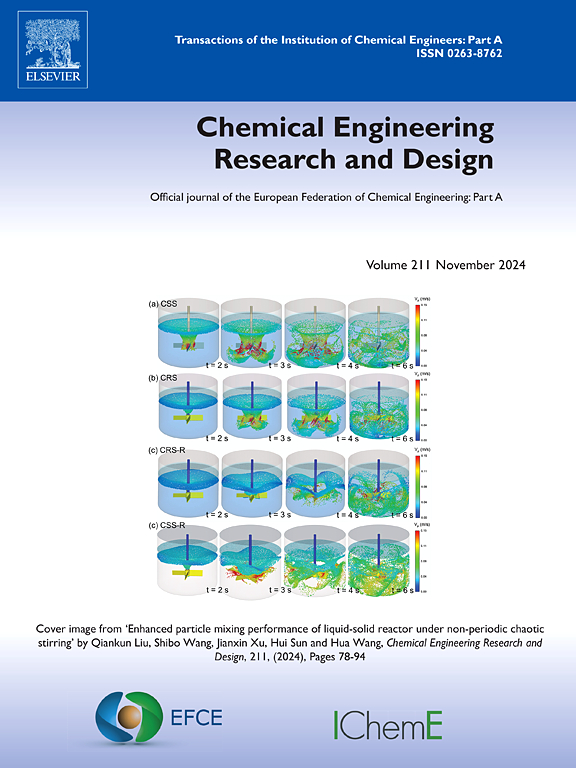纳米铟在二氧化硅上感应加热催化的探索:从室温到热合成新型可持续肥料增强剂1,3-二恶氧烷
IF 3.7
3区 工程技术
Q2 ENGINEERING, CHEMICAL
引用次数: 0
摘要
在这项研究中,我们首次提出了沉积在SiO₂(In/SiO₂)上的铟纳米颗粒体系作为高效催化剂合成1,3-二恶氧烷。我们还报道了首次将In/SiO₂系统纳入感应加热催化(IHC)平台。这种创新的方法消除了对强酸或有机共溶剂的需求。免疫组化是一种相对较新的方法。我们需要测试它的适用性。在我们之前的液相IHC实验中,我们将催化剂装载在IHC活性铁磁性材料上,例如Ni羊毛。现在,我们在大量空白样品的实验中表明,即使在微小的催化量下,我们也通过增加反应物转化观察到IHC效应。In/ sio2催化剂即使在室温下也表现出足够的活性。TOF-SIMS分析表明,反应机理表明铟和二氧化硅之间存在双重协同活化,有利于缩醛化。动力学分析表明,反应发生在动力学区,二阶模型是最合适的。In NPs沉积在颗粒状二氧化硅上的催化剂限制了浸出,并使生产高纯度产品成为可能。我们还研究了perperap™4100HF聚合物膜,用于去除反应后混合物中的水分,有利于改变反应平衡。此外,环酮作为肥料佐剂进行了测试,以提高玉米产量,显示出在不影响作物生产力的情况下减少肥料使用量高达50% %的潜力。这类助剂可能有助于可持续肥料管理,并根据当前和未来的法律法规减少人为碳足迹(联合国- 2030年议程)。本文章由计算机程序翻译,如有差异,请以英文原文为准。
Exploring induction heating catalysis with nano-indium on silica: From room-temperature to thermal synthesis of 1,3-dioxolane as a new sustainable fertilizer enhancer
In this study, we present, for the first time, an indium nanoparticle system deposited on SiO₂ (In/SiO₂) as a highly efficient catalyst synthesizing of 1,3-dioxolanes. We also report, for the first time, the incorporation of the In/SiO₂ system into the Induction Heating Catalysis (IHC) platform. This innovative approach eliminates the need for strong acids or organic co-solvents. IHC is a relatively new method. We need to test its applicability. In our previous IHC experiments in liquid phase, we loaded the catalyst on the IHC active ferromagnetic material, e.g., Ni wool. Now, we show in numerous experiments with blank samples that even at the minute catalytic amount, we are observing the IHC effect through increased reactant conversion. The In/SiO₂ catalyst demonstrated sufficient activity even at room temperature. The reaction mechanism, indicated by TOF-SIMS analysis, reveals a dual synergistic activation between indium and silica, facilitating the acetalization. The kinetic analysis identified a second-order model as the best fit, with the reaction occurring in the kinetic region. The catalyst with In NPs deposited on granulated silica limits leaching and enables the production of high-purity products. We also explored the Pervap™ 4100HF polymer membrane to remove water from post-reaction mixtures, favorably altering the reaction equilibrium. Additionally, cyclic ketals were tested as fertilizer adjuvants to improve maize yields, showing the potential to reduce fertilizer usage by up to 50 % without compromising crop productivity. This class of adjuvants may help for sustainable fertilizer management and reduce the anthropogenic carbon footprint in accordance with current and future legal regulations (United Nations - Agenda 2030).
求助全文
通过发布文献求助,成功后即可免费获取论文全文。
去求助
来源期刊

Chemical Engineering Research & Design
工程技术-工程:化工
CiteScore
6.10
自引率
7.70%
发文量
623
审稿时长
42 days
期刊介绍:
ChERD aims to be the principal international journal for publication of high quality, original papers in chemical engineering.
Papers showing how research results can be used in chemical engineering design, and accounts of experimental or theoretical research work bringing new perspectives to established principles, highlighting unsolved problems or indicating directions for future research, are particularly welcome. Contributions that deal with new developments in plant or processes and that can be given quantitative expression are encouraged. The journal is especially interested in papers that extend the boundaries of traditional chemical engineering.
 求助内容:
求助内容: 应助结果提醒方式:
应助结果提醒方式:


